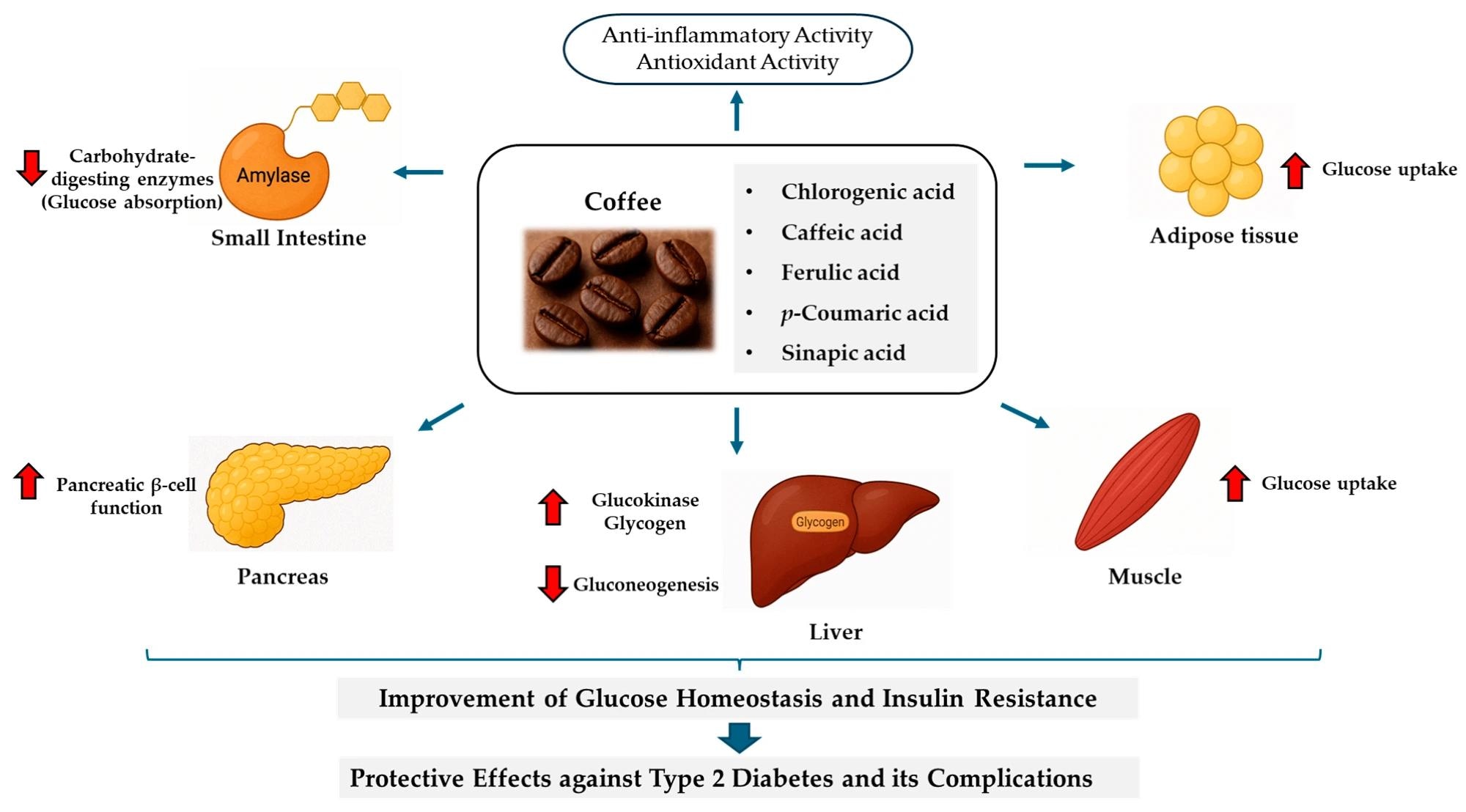New research highlights coffee’s unique polyphenols as promising allies against type 2 diabetes, yet clinical proof remains the missing ingredient.
 Review: Coffee and Its Major Polyphenols in the Prevention and Management of Type 2 Diabetes: A Comprehensive Review. Image Credit: Natasha_Kovtun / Shutterstock
Review: Coffee and Its Major Polyphenols in the Prevention and Management of Type 2 Diabetes: A Comprehensive Review. Image Credit: Natasha_Kovtun / Shutterstock
In a recent review published in the International Journal of Molecular Sciences, researchers compiled data from nearly 150 publications to elucidate the effects of coffee and its metabolites on type 2 diabetes mellitus (T2DM). They focus on evidence from clinical, epidemiological, and molecular studies to unravel coffee's lesser-known associations with T2DM and metabolic diseases.
Findings reveal that coffee-derived polyphenols exhibit significant blood sugar-modulatory effects, including the suppression of inflammation, enhancement of insulin sensitivity, antioxidant properties, and improved glucose metabolism. While this evidence suggests that coffee consumption benefits T2DM, the review highlights several key knowledge gaps, including optimal dosages, bioavailability challenges, and underlying mechanisms.
Background
Type 2 diabetes mellitus (T2DM) represents one of this era's most significant public health crises. Occurring when the body is incapable of optimally managing circulatory blood sugar levels, the condition is growing at an alarming rate, surging from 200 million adult cases (1990) to more than 830 million cases (2022) just three decades later. Projections estimate 783 million cases by 2045, primarily due to aging populations, urbanization, and changes in lifestyle.
While several pharmacological strategies (e.g., the development of Glucagon-like-peptide-1 receptor agonists [GLP-1 RAs]) and lifestyle interventions (e.g., the Dietary Approaches to Stop Hypertension [DASH] diet) have shown promise in mitigating T2DM's adverse outcomes, safe, cheap, and accessible preventive measures are still lacking.
Recent research suggests that coffee, one of the world's most popular beverages, is frequently linked to reduced T2DM incidence. Unfortunately, studies attempting to understand these trends often focus on one (caffeine) or a few coffee polyphenols and use correlation (rather than causation) for their inferences. Though widely consumed, coffee's metabolic impacts have only recently been dissected with the rigor typically reserved for pharmacological agents.
About the review
The present review aims to collate available data on coffee components previously linked to T2DM outcomes, focusing on five hydroxycinnamic acids found in coffee: 1. Chlorogenic acid, 2. Caffeic acid, 3. Ferulic acid, 4. p-Coumaric acid, and 5. Sinapic acid. It seeks to unravel how these polyphenols mechanistically alter glucose metabolism, oxidative stress, and inflammation at both cellular and systemic levels.
Study data were obtained through a systematic and structured review of 149 publications, which comprised epidemiological data, mechanistic studies, observational cohort studies, and clinical trials. The review organized and discussed these publications under the following key points: 1. Epidemiology, 2. Clinical trials, 3. Mechanisms, 4. Pharmacokinetics and bioavailability, and 5. Research gaps.
The review assessed and standardized each section for study quality, sample size, types of coffee used (filtered, espresso, decaf), and polyphenol content (composition and relative quantity). In doing so, the review sought to derive causal associations from the correlation-based investigations.
 Potential anti-diabetic mechanisms of chlorogenic acid and related hydroxycinnamic acids. Red arrows indicate direction: ↑ increase, ↓ decrease.
Potential anti-diabetic mechanisms of chlorogenic acid and related hydroxycinnamic acids. Red arrows indicate direction: ↑ increase, ↓ decrease.
Study findings
Epidemiological evidence suggests that habitual coffee drinking (3-5 cups daily) results in a 20-30% lower risk of future T2DM incidence, highlighting the beverage's protective effects against systemic and cellular glucose imbalances. However, the review cautions that mechanistic and efficacy evidence remains largely preclinical. Notably, while the magnitude of their impact differed between coffee subtypes, both caffeinated and decaffeinated coffee demonstrated similar benefits for T2DM, suggesting that compounds (polyphenols) beyond caffeine play key roles.
Clinical studies, particularly short-term trials, have revealed that chlorogenic acid-enriched coffees improve postprandial glucose levels by 6.9% and reduce fasting insulin levels. However, human trials show inconsistent results, especially in established T2DM, and adverse effects (e.g., hypertension, anxiety) may occur with high intake (>4 cups/day). The review underscores that long-term clinical data remains sparse for uncovering trends and predicting future outcomes.
Mechanistic studies have shown that chlorogenic acid and similar polyphenols inhibit carbohydrate-digesting enzymes and enhance glucose uptake in the muscle and liver, thereby promoting glucose homeostasis. Chlorogenic, caffeic, ferulic, and sinapic acids demonstrate consistent anti-inflammatory effects; p-coumaric acid also shows activity (e.g., TNF-α reduction in animal models), though evidence is less extensive.
Cell models demonstrated ferulic and caffeic acids' beneficial impacts on insulin receptor sensitivity. Bioavailability and metabolism investigations suggest that chlorogenic acid is partially broken down in the gut, significantly impacting gut microbiota profiles, which in turn may mediate some of the coffee-associated benefits for T2DM. Animal studies have consistently demonstrated metabolic improvements across insulin resistance and diabetes models, while ferulic acid has shown synergistic effects when combined with metformin. If confirmed, these findings demonstrate the potential for personalized future treatments.
Limitations and conclusions
The review highlights that contemporary studies share significant drawbacks despite their insights. These include: highly varied polyphenol dosing across trials (e.g., chlorogenic acid at 200–1200 mg/day in human studies), which impedes standardization; low bioavailability requiring efficacy enhancements; population bias from reliance on Asian/European cohorts; mechanistic uncertainty due to limited human evidence; potential adverse effects with excessive consumption; and drug interactions with anti-diabetic medications like ertugliflozin.
Nevertheless, this review underscores coffee's (specifically its polyphenols) untapped potential in preventing or mitigating T2DM. The authors call for rigorous, well-designed clinical trials and metabolic studies to establish coffee polyphenols as evidence-based interventions. In particular, methodological standardizations would hasten both research efforts and public health applications.
Journal reference:
- Kim, H., Kim, S. R., & Jung, U. J. (2025). Coffee and Its Major Polyphenols in the Prevention and Management of Type 2 Diabetes: A Comprehensive Review. International Journal of Molecular Sciences, 26(12), 5544, DOI – 10.3390/ijms26125544, https://www.mdpi.com/1422-0067/26/12/5544